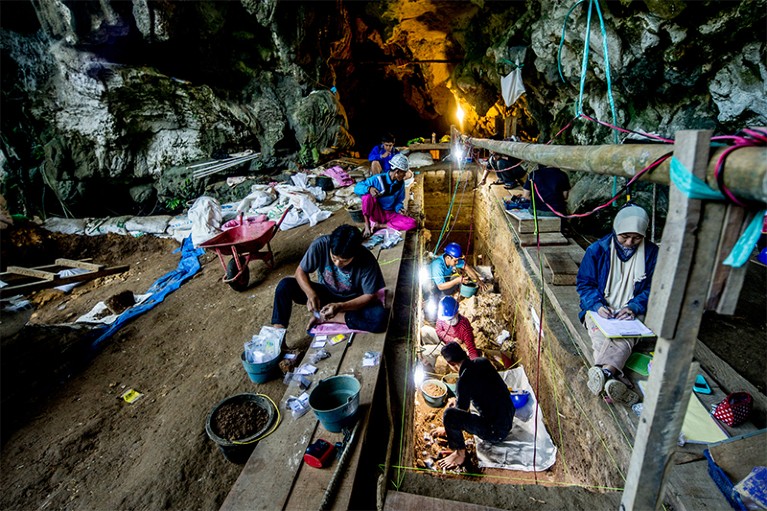
Excavations led by Griffith University at Leang Bulu Bettue, a cave on Sulawesi island, Indonesia.Credit: Justin Mott/Mott Visuals
These 16 institutions were selected from among the most improved institutions in the Nature Index between 2015 and 2017. Some showed exceptional absolute and relative growth in their overall contribution to the papers in the journals tracked by the index, measured by fractional count (FC), whereas others excelled in a specific subject category. Chinese institutions make up more than half of the top 100 rising stars, far exceeding the 20 from the United States, and 4 each from Germany and the Netherlands.
Griffith University
Australia | 2015 FC: 12.8 | 2017 FC: 24.09
Spread across five campuses in Queensland, Griffith University boasts a strong commitment to sustainability, as befits an institution near the Great Barrier Reef.
Part of Nature Index 2018 Rising Stars
The university achieved an 88.1% increase in its fractional count between 2015 and 2017, making it the fastest-rising Australian institution in the Nature Index. Ned Pankhurst, a marine biologist and senior deputy vice chancellor at Griffith, attributes its recent success to two strategic investment programmes: one focussed on specific research areas, including environmental science, water science and climate change response, and a 2020 plan to become one of the most influential universities in the Asia-Pacific region.
Those programmes together have seen an additional Au$60 million (US$43.1 million) in funding since 2010. Overall, Griffith has 1,446 full-time researchers and had a total research budget in 2017 of Au$280 million.
Hui Jun Zhao, an analytic chemist, and director of the Centre for Clean Environment and Energy is among the university’s top contributors to the index. He recently co-authored a paper in water research of a self-cleaning system for monitoring raw sewage in real time.
Griffith is also a founding member of the International WaterCentre, a partnership between four Australian universities that engages communities, practitioners and academics in finding solutions to complex water management problems.
In 2016, Griffith University launched the Australian Research Centre for Human Evolution, which contributed to the recent discovery of the oldest fossil of modern humans outside Africa. — by Bianca Nogrady
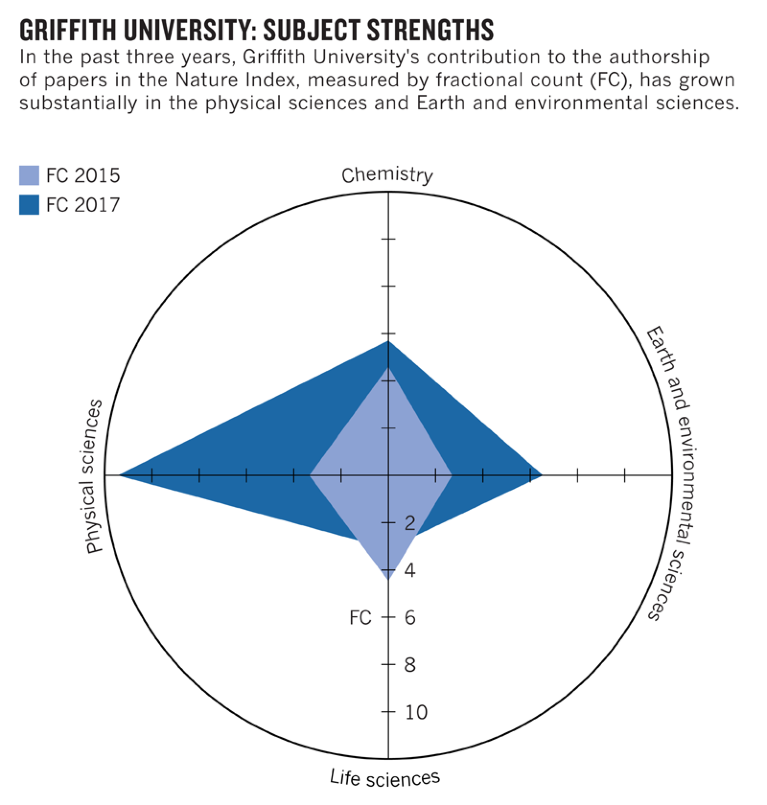
Source: Nature Index
Southeast University
China | 2015 FC: 37.97 | 2017 FC: 75.60
Southeast University (SEU) has long been a science hub in China. It was once part of Nanjing University, but split away in 1952.
Today, its historical strengths in chemistry and physics have powered its growth in the Nature Index, with its output nearly doubling over the past three years. Publications have included research on atom-thin memory storage devices and graphene-based electronic tattoos that can monitor heart rates.
One of the university’s most widely read papers in 2017, however, was in the life sciences: a fruit fly study that investigated the neuronal circuitry that drives flies to either sleep or have sex. Neurobiologist, Yufeng Pan, and his colleagues at the MOE Key Laboratory for Developmental Genes and Human Disease observed that sleep deprivation caused male fruit flies to more often sleep rather than mate, whereas female fruit flies seemed impervious to fatigue.
Pan credits recruitment of a large number of foreign researchers — including through China’s Thousand Talents Plan — for SEU’s growth. Though research in life sciences only began at SEU in the past decade, he thinks the recruitment trend will continue with the recent creation of a joint institute on neuron morphology with the United States-based Allen Institute. The university has 925 doctoral supervisors. — by Mark Zastrow
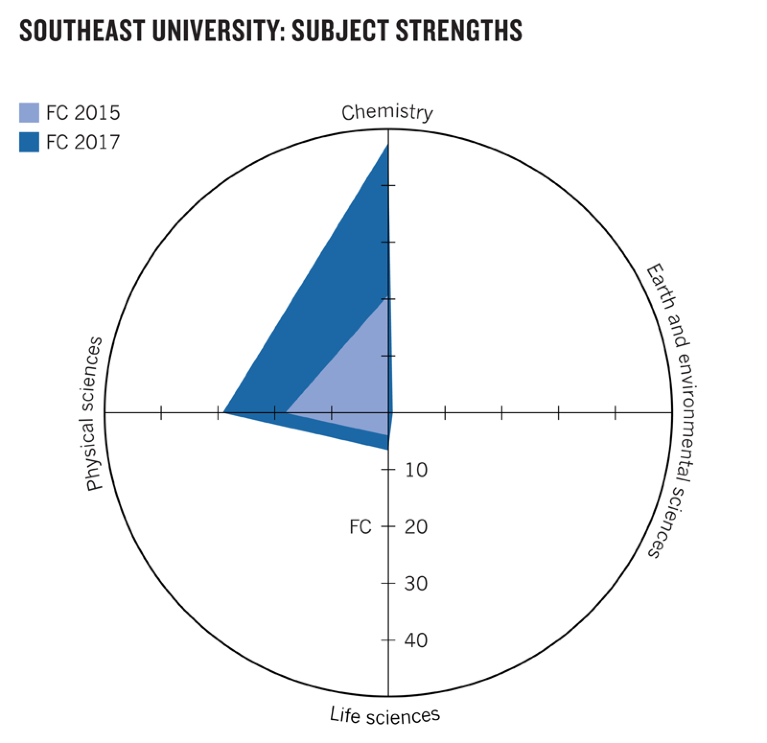
Source: Nature Index
University of Chinese Academy of Sciences
China | 2015 FC: 101.95 | 2017 FC: 255.65
The Chinese Academy of Sciences spans a network of more than 100 research institutes across China — and its affiliated university matches its scale. Headquartered in Beijing, the University of Chinese Academy of Sciences (UCAS) sprawls across four campuses with five satellite branches in other cities, including Shanghai and Chengdu. It counts more than 15,000 instructors and 7,210 doctoral supervisors on staff, with more than 45,000 graduate students.
UCAS is the latest iteration of China’s first graduate university in science, founded in 1978. Still regarded as China’s best graduate school, UCAS began to admit undergraduates in 2014.
The university has shown remarkable growth in its output of high-quality research: from 2015 to 2017, its fractional count increased 151% from 101.95 to 255.65, the largest rise of any institution globally. The pace of growth is sustained across all fields tracked by the index, and contrasts with a 3.4% decline in the output of CAS over the same period. — by Mark Zastrow
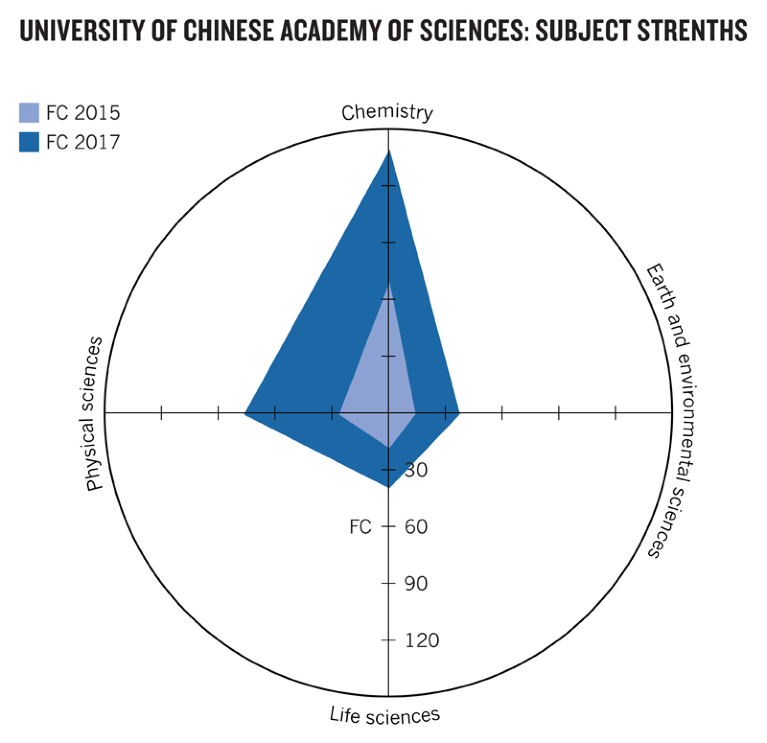
Source: Nature Index
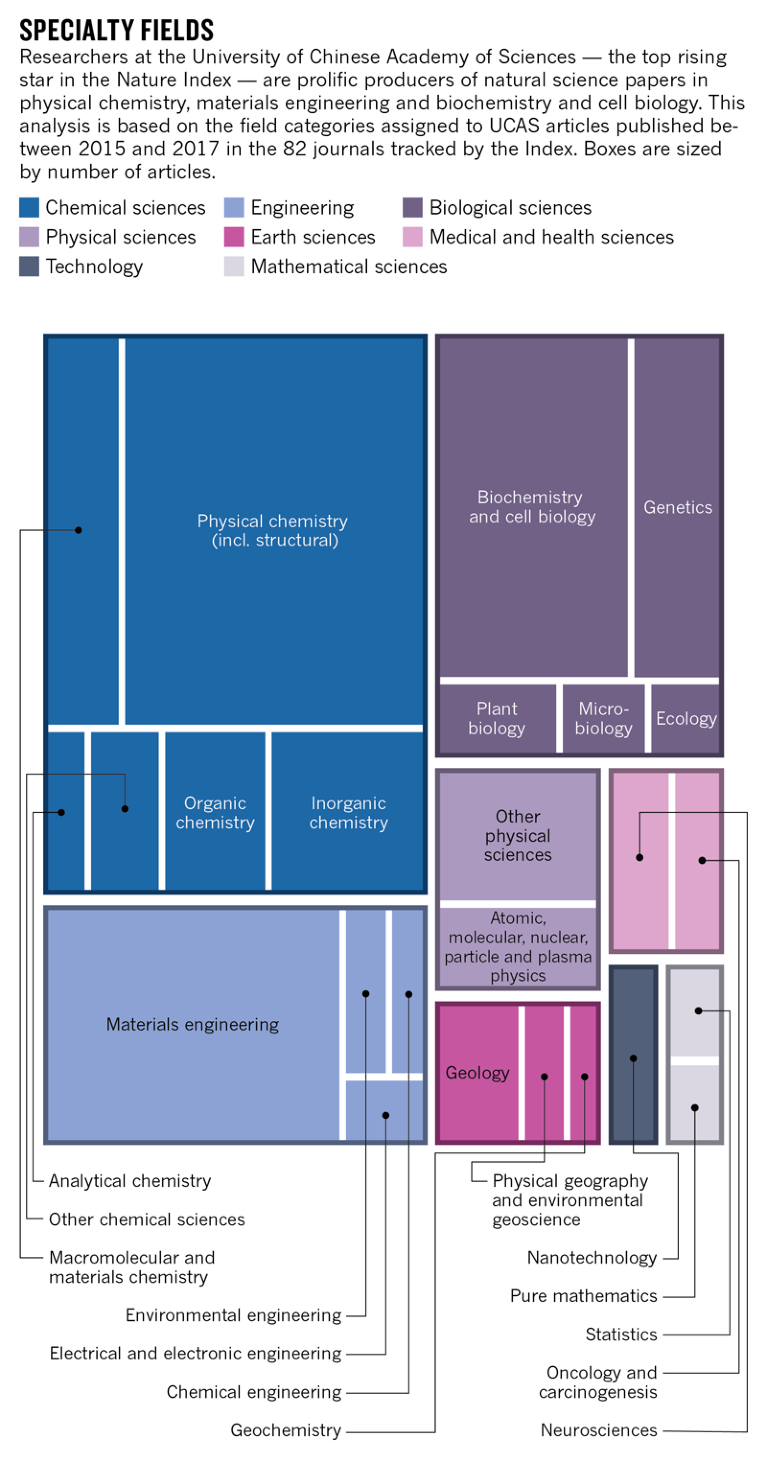
Source: Nature Index/Dimensions from Digital Science
National Center for Atmospheric Research
United States | 2015 FC: 31.55 | 2017 FC: 47.02
The National Center for Atmospheric Research (NCAR) in Boulder, Colorado, was founded in 1960 to assist researchers in their studies of atmospheric and climate science. The aim was to provide faculty members with resources no single university could afford. Those resources now include the NCAR-Wyoming Supercomputing Center, opened in 2012, the Mauna Loa Solar Observatory in Hawaii, and two aircraft for airborne geoscience studies.
These facilities have contributed to NCAR’s rise in prominence in the Nature Index, with a 58.8% increase in its contribution to journals in Earth and environmental sciences between 2015 and 2017.
Growing interest in collaborative research has brought NCAR to the fore, says Gerald Meehl, who heads its climate change research section and is among its top authors in the index. He also attributes the institute’s success to a high percentage of eager young researchers. “We’ve got a crop of young project scientists who are pretty active,” he says.
More than half of NCAR’s funding — US$173 million in 2017 — comes from the United States National Science Foundation, with additional funding from other federal agencies interested in weather and geosciences, including the National Aeronautics and Space Administration, the National Oceanic and Atmospheric Administration, and the departments of defence and energy. NCAR has approximately 494 scientists, postdocs, and engineers on staff. — by Neil Savage
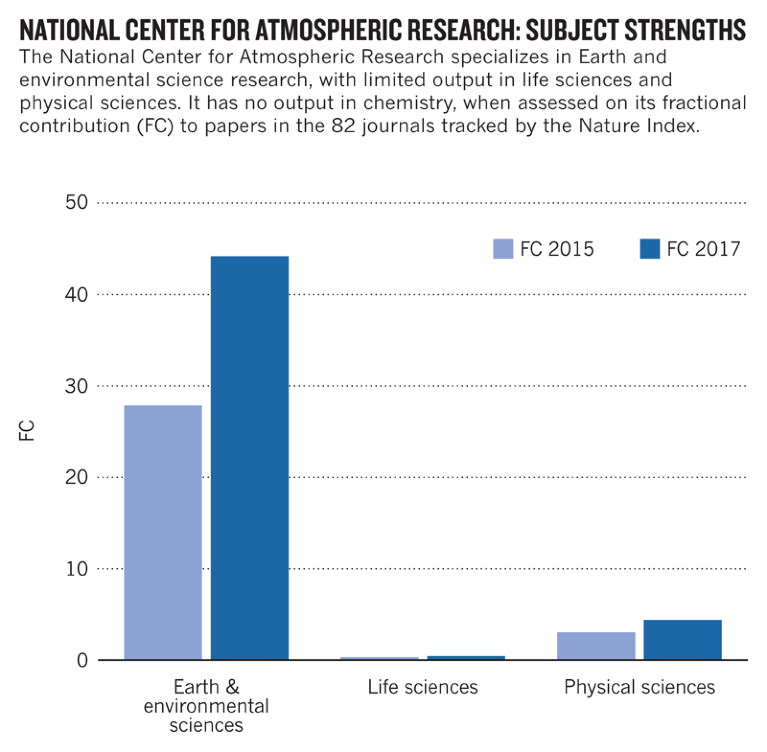
Source: Nature Index
Russian Academy of Sciences
Russia | 2015 FC: 155.38 | 2017 FC: 170.84
Founded in 1724 by decree of Peter the Great, the Russian Academy of Sciences (RAS) is the world’s oldest scientific research network, and represented the height of Russian science through the era of the Soviet Union. But after the Cold War, the institution struggled with budget cuts as state funds shifted towards universities.
In 2013, parliament implemented reforms to the institution, seeking to bring it under control of a federal agency that reports directly to President Vladimir Putin. Critics said the move threatened the academy’s independence.
However, RAS has rebounded in the Nature Index — especially in chemistry, where its output has risen by more than 50%, from a fractional count of 44.21 in 2015 to 66.73 in 2017. In October 2017, an all-RAS team demonstrated a more sustainable 3D printer that uses a material derived from cellulose, the bulk material in plant walls.
Valery Rubakov, a theoretical physicist at the RAS Institute for Nuclear Research in Moscow, says the value of RAS is more recognized today than five years ago. But he warns that if the architects of the 2013 reform continue to exert control, “the system of RAS institutes is in danger of complete destruction.” RAS’s budget in 2013 was 60 billion roubles (US$887 million), and it employed 46,955 researchers in 2016. — by Mark Zastrow
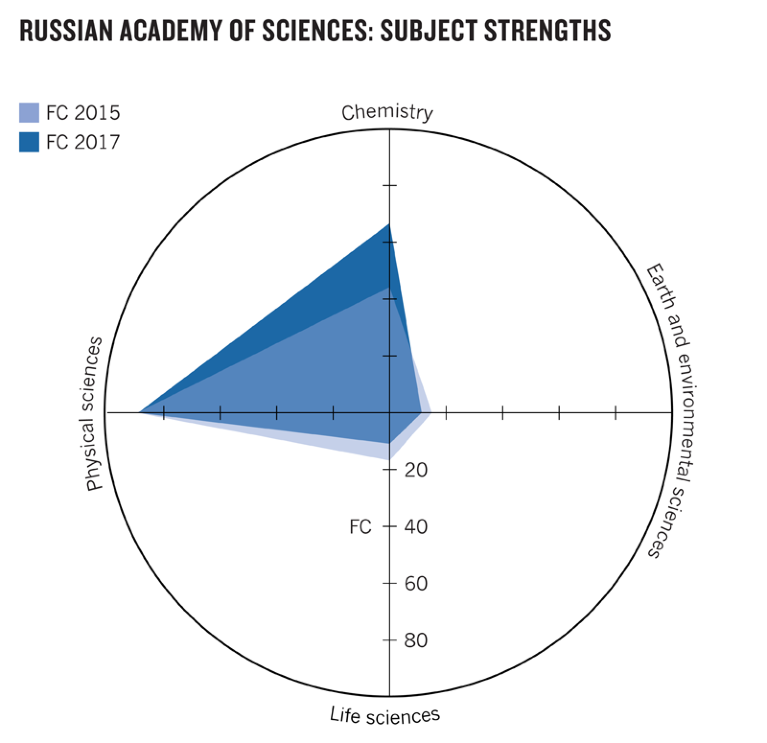
Source: Nature Index
Western University
Canada | 2015 FC: 32.95 | 2017 FC: 46.12
The 140-year-old Western University in Ontario, Canada, has 12 faculties with 1,396 full-time staff and a research budget of more than Ca$225 million (US$172 million) in 2017. The university’s fractional count has increased by 40% in the Nature Index from 2015 to 2017. Its output in the physical sciences has doubled, with noticeable growth in chemistry and the life sciences. Researchers during this period have contributed to numerous papers on emerging materials, astrophysics, and the brain regions controlling behaviours such as paying attention.
John Capone, vice-president (research), attributes the rise to the university’s significant investments in areas such as neuroscience, materials science, wind engineering and medical research. In 2013, for example, the university invested more than Ca$20 million in clusters of research excellence focussed on cognitive neuroscience and musculoskeletal health.
Western University has also secured private and public partnerships, particularly in areas of research with higher equipment and infrastructure costs. Overall, it has invested more than Ca$400 million in infrastructure, including biomedical imaging and high-performance computing facilities at The Brain and Mind Institute. — by Bianca Nogrady
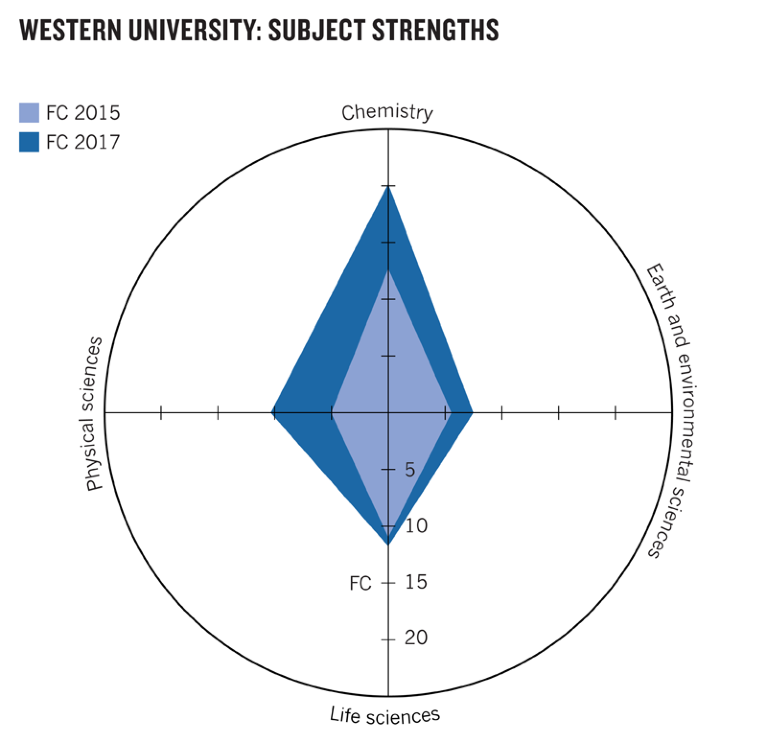
Source: Nature Index
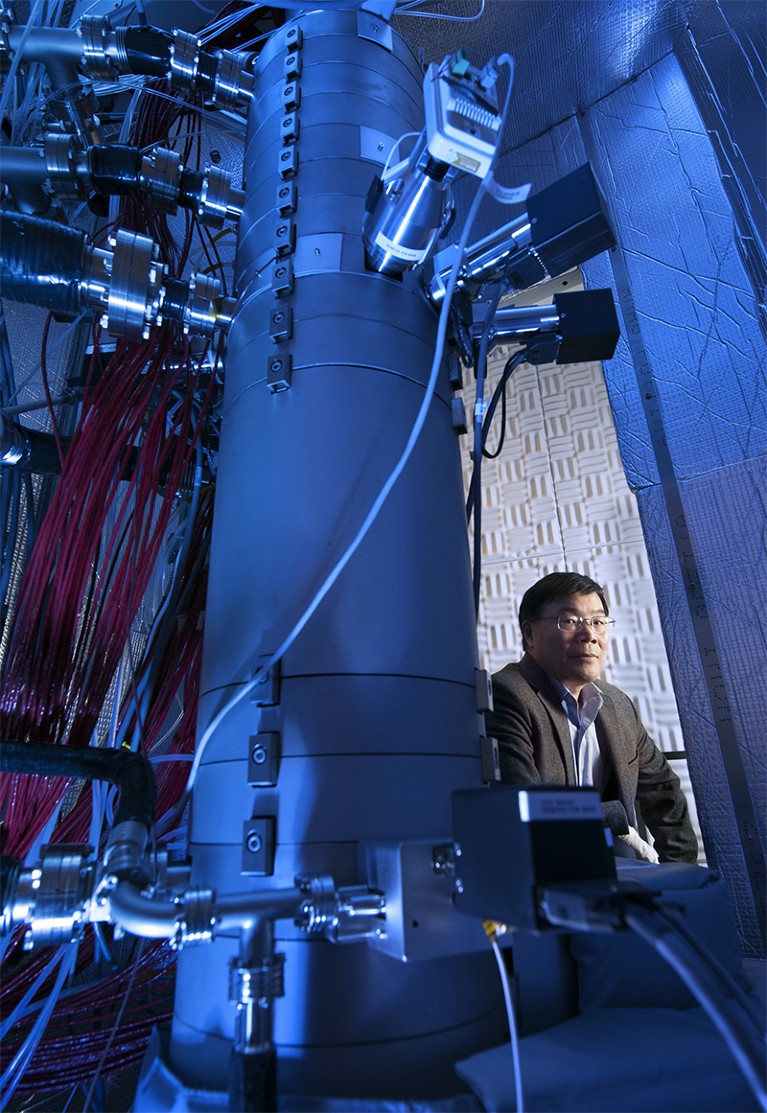
Xiaoqing Pan, director of the newly established Irvine Materials Research Institute, University of California, Irvine. Credit: Steven Zylius/UCI
University of California, Irvine
United States | 2015 FC: 125.68 | 2017 FC: 162.5
The University of California, Irvine (UCI) is North America’s top rising star in the Nature Index, achieving 29.3% growth in its fractional count over the past three years, with increases in all fields.
Founded in 1965, UCI is one of the younger schools in the state’s university system, but has come into its own thanks to an emphasis on building research facilities with advanced equipment, such as the recently opened Irvine Materials Research Institute that includes a state-of-the-art transmission electron microscope.
UCI has also invested in recruitment. “We attract really top-notch faculty,” says Soroosh Sorooshian, director of the Center for Hydrometeorology and Remote Sensing in UCI’s engineering school. The university’s strategic plan, released in 2016, set a target to recruit 250 new faculty members by 2021, welcoming 57 in 2017 alone. That’s a continuation of a hiring plan to recruit a few senior professors and several junior faculty, particularly if they span different departments. Recent high-profile hires include tissue bioengineer Kyriacos Athanasiou, and cognitive scientist, Zygmunt Pizlo, who uses computational modelling to simulate how humans perceive three-dimensional shapes from 2D images.
The university has more than 2,100 research faculty. Its funding for fiscal year 2017 was US$378 million. — by Neil Savage
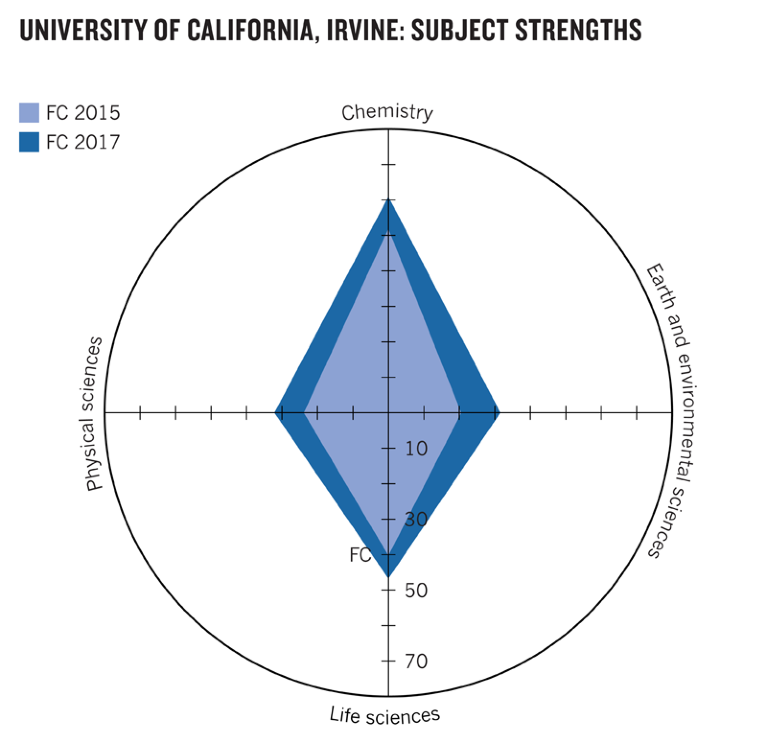
Source: Nature Index
TU Dortmund University
Germany | 2015 WFC: 23.40 | 2017 WFC: 41.82
Located in Germany’s industrial heartland, TU Dortmund University has made fast friends in the 50 years since its establishment. Collaborations have ensured its position among Germany’s top rising stars in the Nature Index, almost doubling its fractional count (FC) since 2015, with even faster growth in chemistry from an FC of 11.86 to 25.59 in 2017. The partnerships have been facilitated by a combination of strong researcher networks, university strategy and a changing grant environment.
In 2012, TU Dortmund joined a €28 million (US$32 million) initiative, funded by the German Research Foundation, to explore the science of solvents. Chemists, physicists and engineers from 50 research groups in seven institutions are part of the fundamental science project to advance green chemistry, medical technologies, and photovoltaics.
Gabriele Sadowski, a chemical engineer and TU Dortmund’s vice-president of research says researchers have also strengthened collaborations across borders and with industry. Physicists from the university are working with colleagues from Russia to improve semiconductor science using the power of electron spin. The university is also part of a joint venture with the pharmaceutical company, Bayer, developing innovative drug-delivery technologies at the chemicals manufacturing centre of Leverkusen.
The university has a faculty of 2,300 and a 2017 budget of €330 million, including third-party funding. — by Anja Krieger
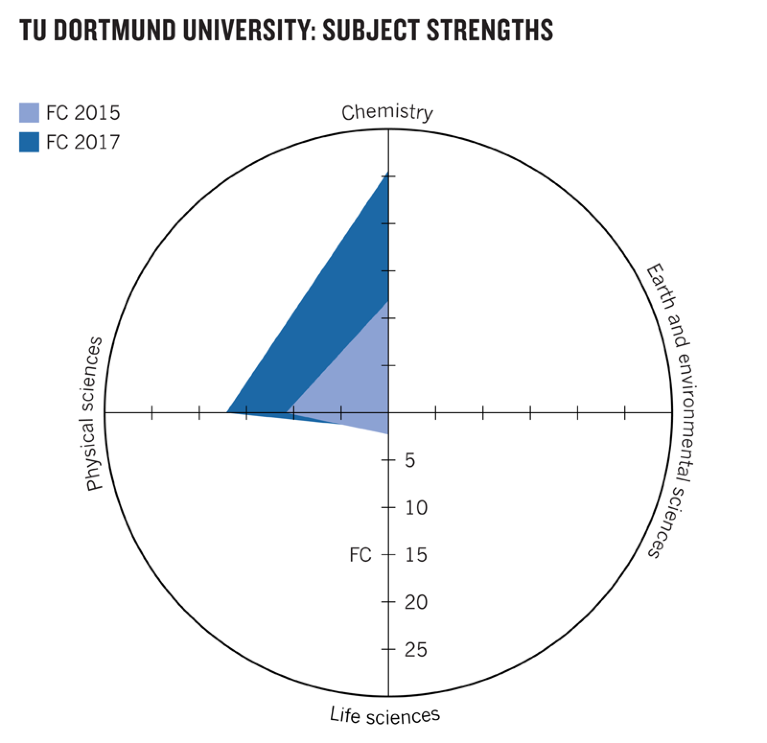
Source: Nature Index
Wageningen University & Research
The Netherlands | 2015 FC: 34.45* | 2017 FC: 50.55
The founding of Wageningen University in 1876 marked the beginning of the Netherlands’s agricultural education programme, a legacy upheld to this day. In 2016, the university merged with its eight research institutes to form one entity: Wageningen University & Research (WUR).
Between 2015 and 2017, Wageningen University’s fractional count (FC) increased 62% to 43.59. Adding the newly incorporated institutions to the 2017 figure increased the FC to 50.55. Particularly notable, has been WUR’s growth in Earth and environmental sciences, from 11.77 to 18.82.
With a full-time faculty of almost 5,000, the university focusses on three core areas — food production, living environment, and livelihood — covering such diverse areas as non-chemical pest control, a faster route to vaccines, and improving the sustainability of banana plantations. WUR has also prioritized investments in broad research themes, such as resource-use efficiency, metropolitan solutions, synthetic biology, and resilience.
Biogeochemist Dolf Weijers is among its most prolific researchers in the index. Most recently, he led a study into the 700-million-year-long evolution of the hormone auxin, which controls processes involved in plant growth and development. — by Bianca Nogrady
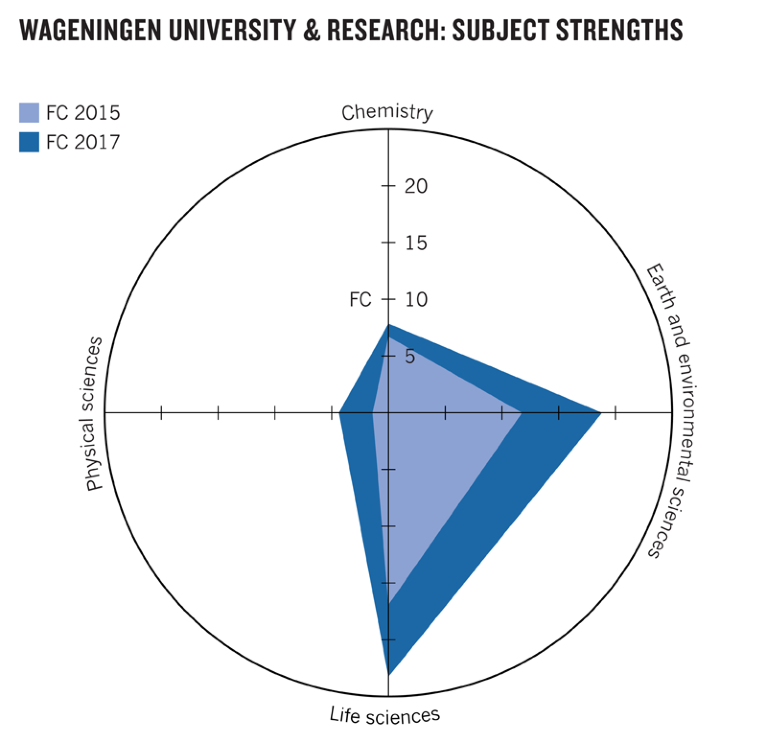
Source: Nature Index
Hunan University
China | Physical sciences FC 2015: 4.5 | 2017 FC: 23.46
Located in the city of Changsha in south-central China, Hunan University (HNU) has seen remarkable growth in physical sciences, with its output in the field increasing more than four-fold in the index between 2015 and 2017, easing declines in chemistry.
Yet HNU’s predominant strengths remain chemistry and materials science. It has two state-funded key labs — China’s elite national laboratories — one for vehicle design and manufacturing, and one for biosensing and data-driven chemistry analysis. The latter accounts for roughly half of HNU’s research in the index.
Chemist, Xidong Duan, of the biosensing lab says that increased support from the central Chinese government has contributed to HNU’s standing, as well as university policies that have sought close collaborations with top scientists abroad. In 2017, he and UCLA’s Xiangfeng Duan published a paper in Science demonstrating a method for producing super-thin semiconductors with intricate structures just a few atoms thick.
Hunan has 1,950 faculty, of which more than 1,400 are professors. — by Mark Zastrow
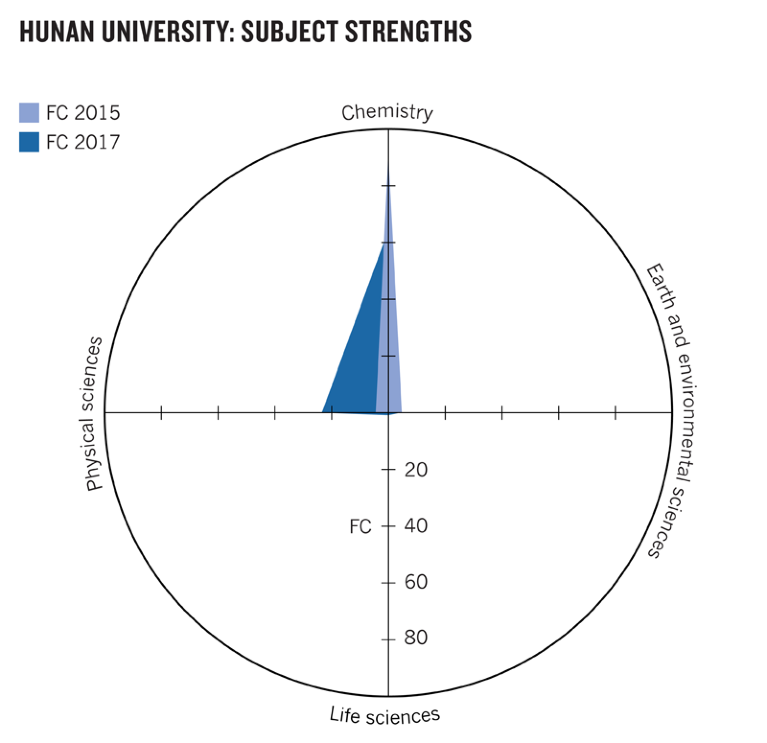
Source: Nature Index
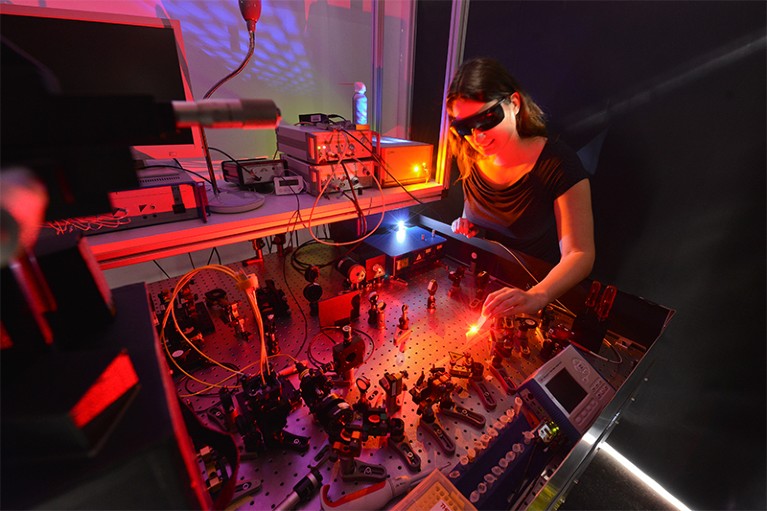
Laser devices are used by polymer physicists at Martin Luther University Halle-Wittenberg to determine how proteins are folded. Credit: Markus Scholz/MLU
Martin Luther University Halle-Wittenberg
Germany | 2015 WFC: 18.81 | 2017 WFC: 29.18
Martin Luther University Halle-Wittenberg was established in 1817 as the largest university in Germany’s state of Saxony-Anhalt. The Nazi regime and subsequent politicisation of academia in East Germany took a toll on the university’s faculty and programmes. After the fall of the Berlin Wall, MLU emerged as a medium-sized university, with around 340 professors among its faculty in 2017, offering the panoply of science subjects. Its research and teaching budget in 2017 was €205 million (US$238 million), excluding third-party funding.
MLU’s rise in the Nature Index has been driven by its chemistry output: between 2015 and 2017, its contribution to articles in this field almost tripled. To Wolfgang Binder, dean of the faculty of natural sciences, MLU’s interdisciplinary approach of connecting physics, chemistry and biology has laid the groundwork for this success.
MLU’s Institute of Chemistry conducts research on subjects ranging from nano-structured and self-healing polymers, to the role of protein misfolding in Alzheimer’s and Parkinson’s diseases, and liquid crystals used in flat-panel displays (LCDs). In 2016, MLU chemist, Carsten Tschierske and his team, in collaboration with Trinity College Dublin, published research on materials that could make liquid-crystal technology faster and more energy-efficient. — by Anja Krieger
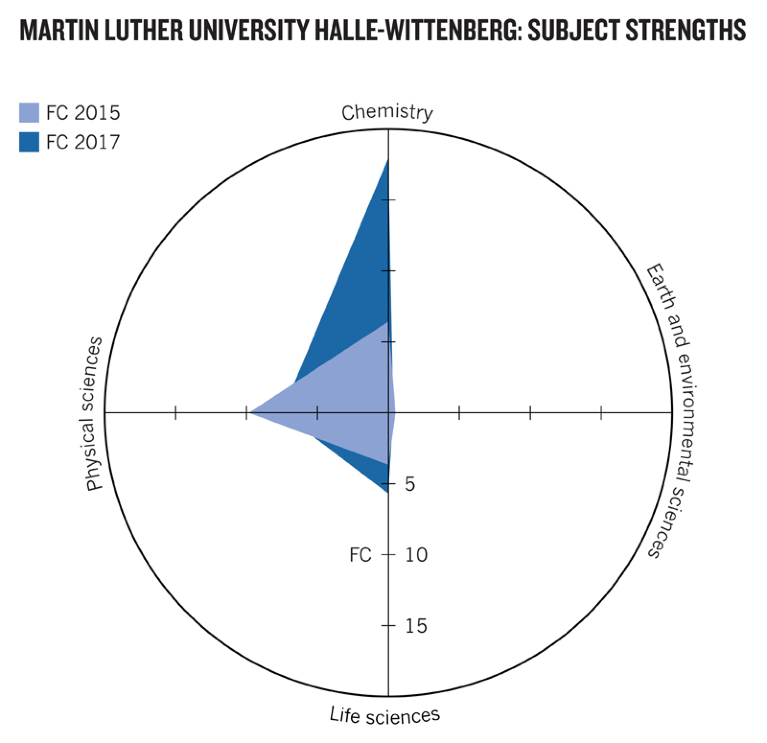
Source: Nature Index
Fudan University
China | E&E sciences 2015 FC: 5.67 | 2017 FC: 18.40
Fudan University in Shanghai is a member of the elite C9 League — nine schools sometimes referred to as China’s Ivy League. The designation comes directly from the Chinese government, and accords it extra resources and funding. This has been key in luring international researchers, and getting more Chinese researchers who studied overseas to return.
As the government pushes to clean up China’s dangerously polluted air and mitigate the effects of climate change, Fudan is helping lead the way. The government’s push has given the university many opportunities, says environmental chemist Zhen Ma, whose particular focus is on practical solutions.
Fudan’s output in Earth and environmental sciences more than tripled in the index between 2015 and 2017. Work led by Kan Haidong of Fudan’s School of Public Health published in 2017 showed that exposure to fine particulate matter less than 2.5 microns in diameter (PM2.5) is linked to blood inflammation and the production of stress hormones, increasing cardiovascular risk.
The university’s output in Earth and environmental sciences is set to grow further: in April 2018, it opened a department for atmospheric and oceanic research. — by Mark Zastrow
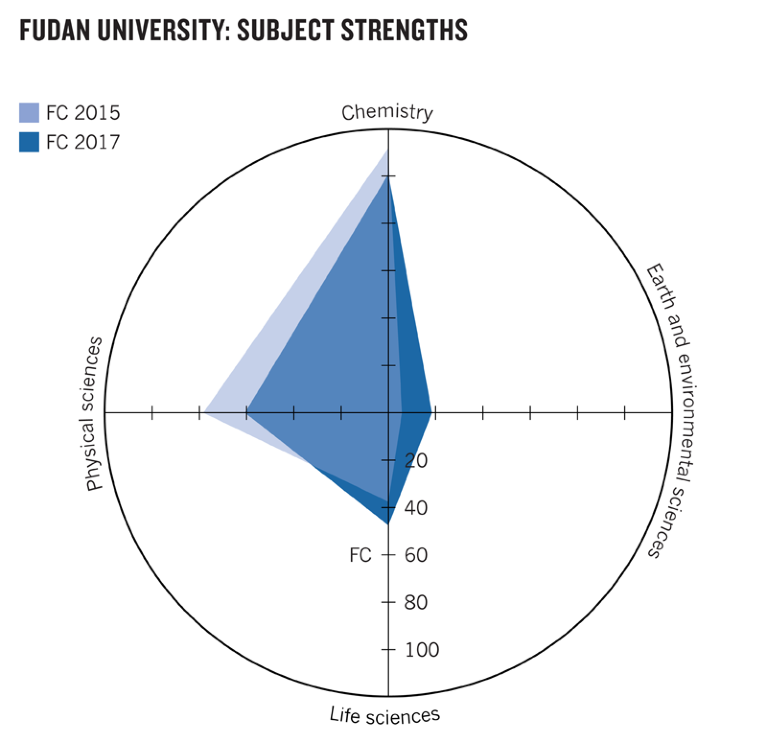
Source: Nature Index
University of Oslo
Norway | 2015 FC: 43.46 | 2017 FC: 65.58
Every five years, the Research Council of Norway offers national research institutions generous ten-year grants to set up centres of excellence in key research areas. The University of Oslo (UiO) has won 17 of the 44 centres since the programme’s launch in 2003. Nine centres are active, covering subjects ranging from solar physics to multilingualism and Earth dynamics.
Four centres have been in Earth and environmental sciences, where the university’s growth in the index has been particularly strong. UiO’s contribution to the authorship in this field has nearly doubled over the past three years, exceeding its 51% growth overall.
The centres give the best and most active researchers more money, says Bjørn Jamtveit, a geophysicist at UiO. The university has also received a significant increase in government funding for climate science, Jamtveit says, which has spurred high-quality publications and participation in collaborations with universities such as the University of California, Berkeley, UC San Diego, and Ecole Normal Superieure de Lyon.
Knut Breivik, an environmental scientist at the Norwegian Institute for Air Research, says collaborations between the school and research institutes encourage a mix of basic and applied environmental research.
The research budget at UiO was 3.39 billion NOK (US$404 million) in 2016, with about 3,635 faculty performing research. — by Neil Savage
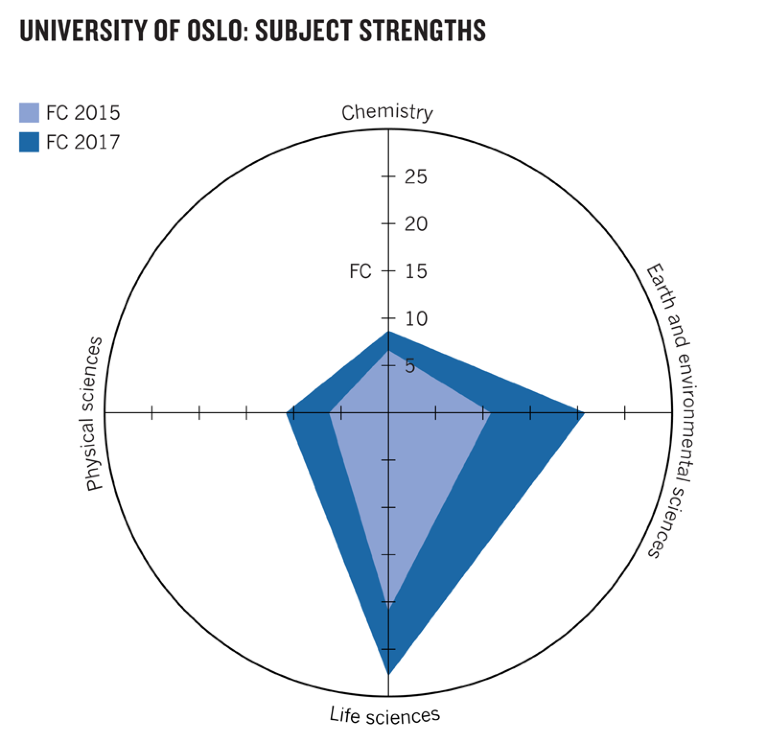
Source: Nature Index
Qufu Normal University
China | 2015 FC: 1.21 | 2017 FC: 12.66
The city of Qufu has a long history of scholarship: it is the hometown of Confucius.
Qufu Normal University (QFNU) is just coming into its own as a presence in the index. In the last three years, it has seen its fractional count multiply by the largest factor of any institution globally, from 1.21 to 12.66. Its papers in the journals tracked by the index are in chemistry and physics.
Among them, analytic chemist, Fengli Qu, has co-authored a flurry of articles on efficient catalysts for the large-scale production of hydrogen, which has promise as a clean source of fuel and long-term storage reservoir for renewable energy. In the past few years, QFNU has transformed itself from a traditional teaching university to a comprehensive research university, says Qu. One of the most effective policies for improvement, he says, has been the introduction of bonus incentives for research. The university has more than 700 professor positions. In 2002, it expanded to a second campus located in Rizhao, on the Yellow Sea — a city known for its sustainability and adoption of solar water heaters in every new building. — by Mark Zastrow
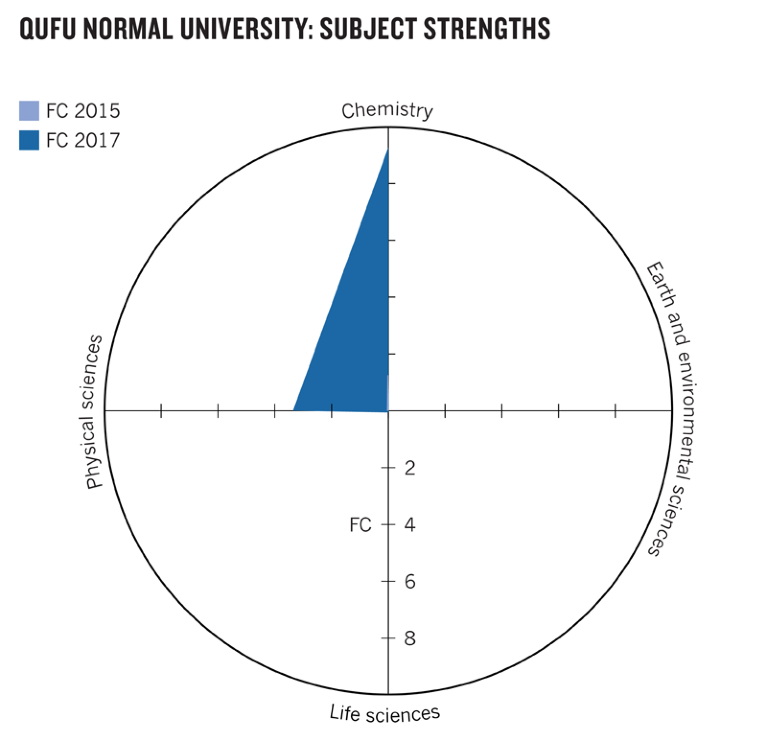
Source: Nature Index

 The fast track
The fast track
 The world at their feet
The world at their feet
 Challenger states
Challenger states
 Discovery relies on strong support staff
Discovery relies on strong support staff
 Green shoots
Green shoots
 Predicting scientific success
Predicting scientific success
 A guide to the Nature Index
A guide to the Nature Index








